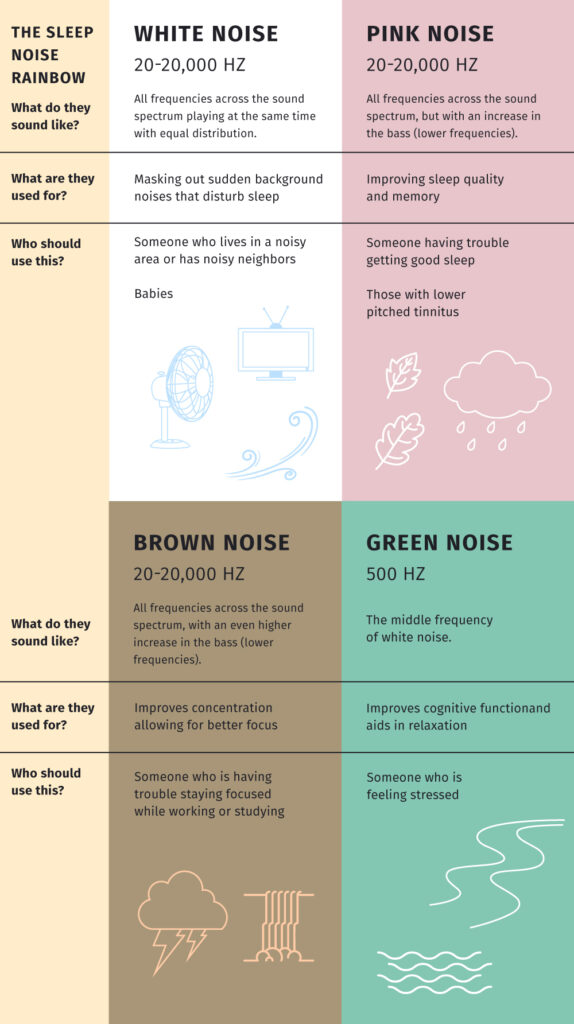What is Pink Noise for Sleep?
If you have trouble falling or staying asleep, you have likely tried all sorts of things to get better rest. One common solution, particularly for people bothered by periodic noises keeping them awake, is to listen to white noise.
But it turns out that white noise isn’t the only type of noise that can help you sleep–in fact, there are many colors of noise. Pink noise is one colored noise that research indicates is capable of relaxing people and helping them get more restorative sleep.
What Does Pink Noise Sound Like?
People who use pink noise to sleep often describe it as resembling sounds in nature. This may contribute to its relaxing qualities. While individual perceptions vary, pink noise can sound like:
- Rustling leaves
- Gentle rain
- Waves on the beach
- A steadily flowing river
Unlike nature soundtracks featuring the above sounds, however, a pink noise track does not change at all over the course of a recording. Instead, the sound is the same from one moment to the next. This gives it a seamless, consistent quality.
White Noise vs Pink Noise
Both white and pink noise can help you sleep better, so what is the difference between them? To better understand this, it’s helpful to understand precisely how sound engineers create these types of noise.
Different colors of noise come from specific combinations of sound frequencies. A frequency describes the pitch of a sound, so high frequencies correspond to high-pitched sounds, and low frequencies correspond to low-pitched sounds.
You get white noise when you take all of the frequencies from 20 Hz to 20,000 Hz (the range perceptible to the human ear) and play them simultaneously and at the same power (volume). That’s why white noise is so fantastic at drowning out random sounds and helping people who are easily distracted or live in noisy areas fall asleep. For example, it can drown out a high-pitched voice or a low-pitched crash because those sounds are already playing.
“Pink noise is like white noise, but instead of having equal power across frequencies, pink noise comes out louder and more powerful at the lower frequencies (think of it as white noise with the bass turned up),” Berkeley Wellness explains. “Pink noise is often found in nature, such as waves lapping on the beach, leaves rustling in the trees, or a steady rainfall.” If you find that the power of the higher pitches in white noise makes the sound feel artificial or distracting, pink noise is a good alternative.
The Colors of Noise
White Noise vs Pink Noise vs Brown Noise vs Green Noise

While white and pink noise are the two most commonly used for sleep, there are many colors of noise. The four you are most likely to hear about are white, pink, brown, and green noise.
White Noise
Marta De la Cruz, a clinical psychologist at Balance Luxury Rehab, explains that “White noise is a combination of all frequencies of sound and can block out sudden noises from interrupting sleep…It is termed “white” because it is similar to white light, which comprises all of the visible spectrum’s hues at equal intensity.”
White noise is great at blocking out sounds of all frequencies, so it’s beneficial if you live in a noisy area or household where unexpected sounds occur regularly. It is also commonly used to help babies sleep.
Pink Noise
Pink noise uses the same frequencies as white noise but adds volume to the lower frequencies (you can think of it like the bass tones). Because many sounds in nature consist primarily of lower frequencies, some people find that pink noise sounds more natural than white noise.
Dr. Meeta Singh, a board-certified physician and psychiatrist concentrated in the applied science of sleep, notes that “pink noise can be beneficial for people who find white noise too harsh or artificial.” As for pink noise’s sleep benefits, she explains that “it may improve sleep quality and support a deeper, more restorative sleep.”
Brown Noise
Brown noise essentially turns pink noise up a notch by further increasing the power of the lower frequencies. As a result, brown noise also sounds like a natural phenomenon, but more like a thunderstorm or crashing waterfall than a gentle rain or smoothly flowing river.
If you are looking for background noise that helps increase focus and concentration, brown noise is a great choice. In addition, Dr. Singh notes that “brown noise may be helpful for people who prefer an even deeper, more soothing sound to help them sleep.”
Green Noise
Green noise differs from white, pink, and brown noise because it focuses its sound around one frequency (500 Hz). This type of noise is fantastic for studying and may improve cognitive function. In addition, many people find green noise relaxing, so while it is not as commonly used for sleep as white or pink noise, some may find it helps them calm down and fall asleep.
Different individuals have varying experiences with each color of noise. Dr. Singh states, “Ultimately, the choice of colored noise for sleep depends on personal preference and the specific sleep-related issues an individual faces. Experimenting with different types of colored noise can help determine which one is most effective for promoting relaxation and improving sleep quality.”
Pink Noise Benefits
Pink noise has an array of benefits during both waking and sleeping hours. Some of the potential benefits of pink noise include:
- Improving sleep efficiency
- Enhancing cognitive function
- Improving memory consolidation
- Masking tinnitus
- Promoting relaxation and a sense of calm
- Reducing stress
Memory
One of the most noteworthy benefits of pink noise outside of helping you get better sleep is in the area of memory. According to a 2017 paper published in Frontiers in Human Neuroscience, pink noise may improve memory and sleep in older adults. A research team including Dr. Phyllis Zee, professor of neurology at the Northwestern University Feinberg School of Medicine, observed 13 adults over the age of 60 as they spent two nights in a sleep lab.
The participants took a memory test each night and slept wearing headphones and an electrode cap. On one night, participants experienced short bursts of pink noise, timed to match their sleep’s slow-wave oscillations, when deep sleep occurs. On the other night, participants did not experience any noise. Participants repeated the memory test from the previous evening on both mornings.
“After analyzing everyone’s sleep waves, the team found that people’s slow-wave oscillations increased on the nights punctuated by pink noise,” reported Amanda MacMillan in TIME. “Come morning, people who had listened to it performed three times better on memory tests than they had the other night. On the nights without the noise, memory recall did not improve as much.”
Other research supports the idea that pink noise helps with memory consolidation. Although the reasoning behind this phenomenon is yet unknown, researchers at the University of Texas at El Paso hypothesize that it could be because “pink noise is the most common signal in biological systems.” They note that “in particular, pink noise is a good description of signals corresponding to mental activities.”
While scientists may not know precisely why, they agree that “acoustic stimulation during sleep enhances sleep and enhances memory” and that “pink noise leads to the most efficient stimulation.”
Is Pink Noise Good for Sleep?
Even though white noise is the best-known colored noise for enhancing sleep, pink noise could potentially be the best at improving your overall sleep quality. As Dr. Michelle Drerup of the Cleveland Clinic notes, “pink noise actually enhances brain activity that’s associated with deep phases of sleep.”
This is not surprising, given the potential benefits of pink noise on memory, as deep sleep is the sleep phase in which memory consolidation occurs. Deep sleep is also essential for many more of the body’s restorative processes in areas such as:
- Immune function
- Energy restoration
- Cell regeneration
- Tissue and bone growth and repair
Aside from potentially increasing the quality and quantity of deep sleep, pink noise is useful for those who need help falling asleep. White and pink noise are the two colored noises that best suit this purpose, so which you choose mostly relates to personal preference.
Pink noise has a more relaxing, natural sound that may soothe you to sleep and can mask noises with lower pitches. White noise is more like static, with constant volume across high, medium, and low frequencies, and is potentially more helpful if you live in a noisy area.
Final Thoughts
If you have trouble falling asleep or wake up unrefreshed, pink noise may be the right choice for you. Research suggests that pink noise may increase the quality of deep sleep, resulting in more restorative sleep and even improved memory. Given that there are no known risks to using colored noise for sleep, it is certainly worth giving pink noise a try. You can also try out different colored noise types on YouTube before investing in a noise machine or subscription-based app.
FAQs
What color noise is best for sleep?
White and pink noise are both helpful for sleep and which is best for you depends on your specific needs. White noise helps keep intermittent noises throughout the night from keeping you awake or waking you up, while pink noise may improve your overall sleep quality and memory consolidation.
Is pink noise better than white?
Pink noise is better than white noise for some people, particularly those who prefer a more natural sound and anyone looking for improvements in sleep quality. White noise is slightly better than pink noise at masking background sounds.
How do you listen to pink noise?
You may not be able to find a pink noise machine, but many white noise machines actually have pink noise as an option. In addition, you can find pink noise soundtracks on YouTube and via various apps on your phone.
Can pink noise be harmful?
There are no known adverse consequences of using pink noise. The Cleveland Clinic notes that “pink noise, white noise or any type of sound is generally safe for anyone to use.”
Does pink noise help tinnitus?
Pink noise can help tinnitus, particularly for those suffering from tinnitus in the lower tones. The color of noise best for tinnitus is one that focuses on frequencies similar to those experienced by the person with tinnitus.

